Keywords:LLM interaction interface, AGI debate, Gemini App strategy, AI companion ethics, Qwen3 model, RAG technology, Transformer alternative architecture, AI model release, Karpathy visual interaction interface, Agentic RAG core elements, Liquid Foundation Models architecture, Phi-4-Reasoning training method, NotebookLM system prompt reverse engineering
🔥 Spotlight
Karpathy’s vision for the future LLM interaction interface: Karpathy predicts that future interaction with LLMs will transcend the current text terminal model, evolving into a visual, generative, interactive 2D canvas interface. This interface will be generated on-the-fly based on user needs, integrating various elements like images, charts, and animations, offering a higher information density and a more intuitive experience, similar to depictions in sci-fi works like ‘Iron Man’. He believes that current elements like Markdown and code blocks are just early prototypes (Source: karpathy)

Debate ignites over whether AGI is a key milestone: Arvind Narayanan and Sayash Kapoor published an article on AI Snake Oil, deeply exploring the concept of AGI (Artificial General Intelligence), arguing it’s not a clear technological milestone or inflection point. The article argues from multiple perspectives—economic impact (diffusion takes time), geopolitics (capability doesn’t equal power), risk (distinguishing capability from power), definition dilemma (retrospective judgment)—that even reaching a certain AGI capability threshold won’t immediately trigger disruptive economic or social effects. Excessive focus on AGI might divert attention from current practical AI issues (Source: random_walker, random_walker, random_walker, random_walker, random_walker)

Google DeepMind head elaborates on Gemini App strategy: Demis Hassabis retweeted and endorsed Josh Woodward’s explanation of the future strategy for the Gemini App. The strategy revolves around three core pillars: Personal, providing services that better understand the user by integrating their Google ecosystem data (Gmail, Photos, etc.); Proactive, anticipating needs and offering insights and action suggestions before the user asks; and Powerful, leveraging DeepMind models (like 2.5 Pro) for research, orchestration, and multimodal content generation. The goal is to create a powerful personal AI assistant that feels like an extension of the user (Source: demishassabis)
Meta’s development of AI companions sparks ethical and social discussion: Mark Zuckerberg mentioned in an interview that Meta is developing AI friends/companions to meet social needs (citing “the average American has 3 friends, but the need is 15”). This plan has sparked widespread discussion, potentially offering solace to lonely individuals on one hand, while raising concerns about further eroding real social connections, exacerbating social atomization, and data privacy ethics on the other (Source: Reddit r/artificial, dwarkesh_sp, nptacek)

🎯 Trends
Wave of AI model releases continues: Several institutions recently released new models: Alibaba released the Qwen3 series (including 0.6B to 235B MoE); AI2 released the OLMo 2 1B model, outperforming Gemma 3 1B and Llama 3.2 1B; Microsoft released the Phi-4 series (Mini 3.8B, Reasoning 14B); DeepSeek released Prover V2 671B MoE; Xiaomi released MiMo 7B; Kyutai released Helium 2B; JetBrains released the Mellum 4B code completion model. Open-source community model capabilities continue to improve rapidly (Source: huggingface, teortaxesTex, finbarrtimbers, code_star, scaling01, ClementDelangue, tokenbender, karminski3)
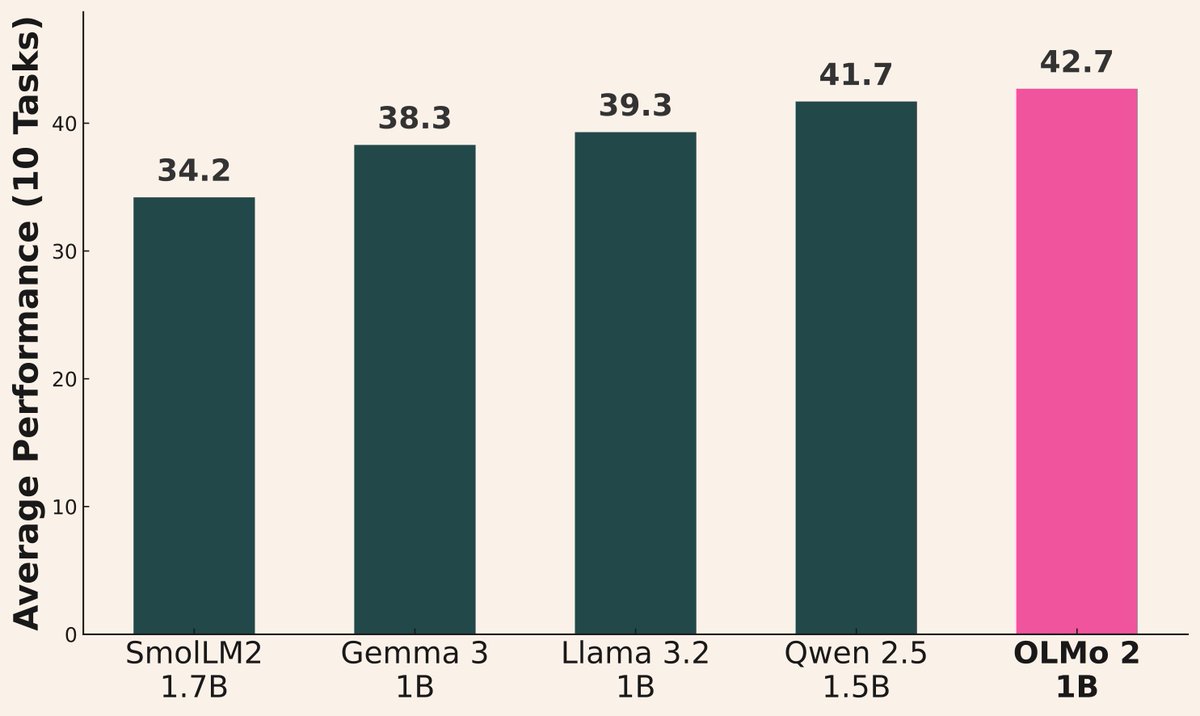
Qwen3 series models show impressive performance: Community feedback indicates excellent performance from the Qwen3 series models. Qwen3 32B is considered to be at the o3-mini level but more cost-effective; Qwen3 4B performs exceptionally well in specific tests (like counting ‘R’s in “strawberry”) and RAG tasks, even being used by some users as a replacement for Gemini 2.5 Pro; the 30B MoE model demonstrates outstanding multilingual translation capabilities (including dialects). Some users observed that Qwen3 235B MoE admits its knowledge boundaries when unable to answer, rather than fabricating information, potentially suggesting improvements in handling hallucinations (Source: scaling01, Reddit r/LocalLLaMA, Reddit r/LocalLLaMA, Reddit r/LocalLLaMA, Reddit r/LocalLLaMA, teortaxesTex, scaling01)
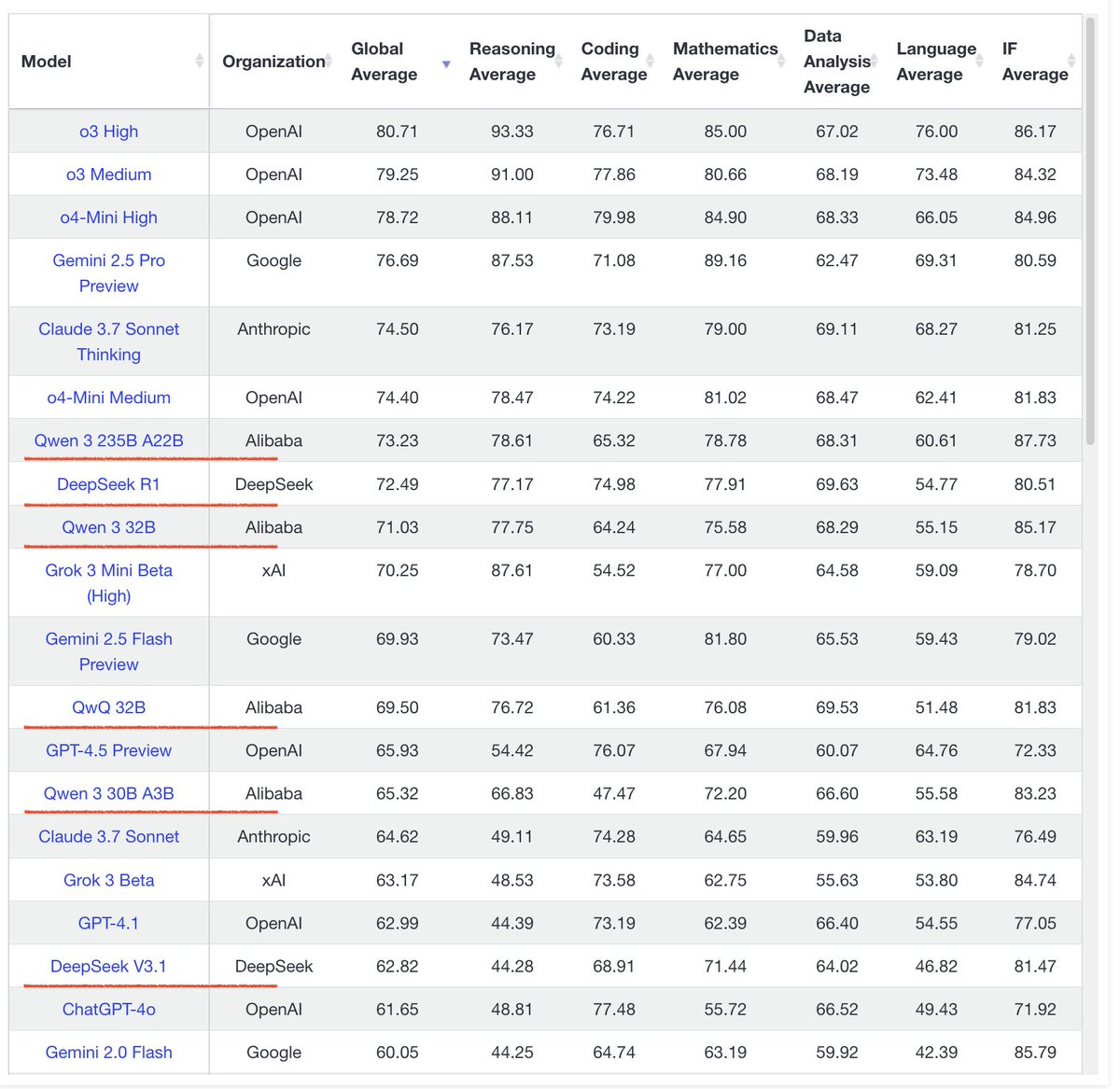
Retrieval and RAG technologies continue to advance: ReasonIR-8B was released, the first retriever specifically trained for reasoning tasks, achieving SOTA on relevant benchmarks. The concept of Agentic RAG is emphasized, focusing on leveraging memory (long-term/short-term), tool use, and reasoning (planning, reflection) to enhance the RAG process. A user conducted comparative tests of local LLMs (Qwen3, Gemma3, Phi-4) on Agentic RAG tasks, finding Qwen3 performed relatively well (Source: Tim_Dettmers, Muennighoff, bobvanluijt, Reddit r/LocalLLaMA)
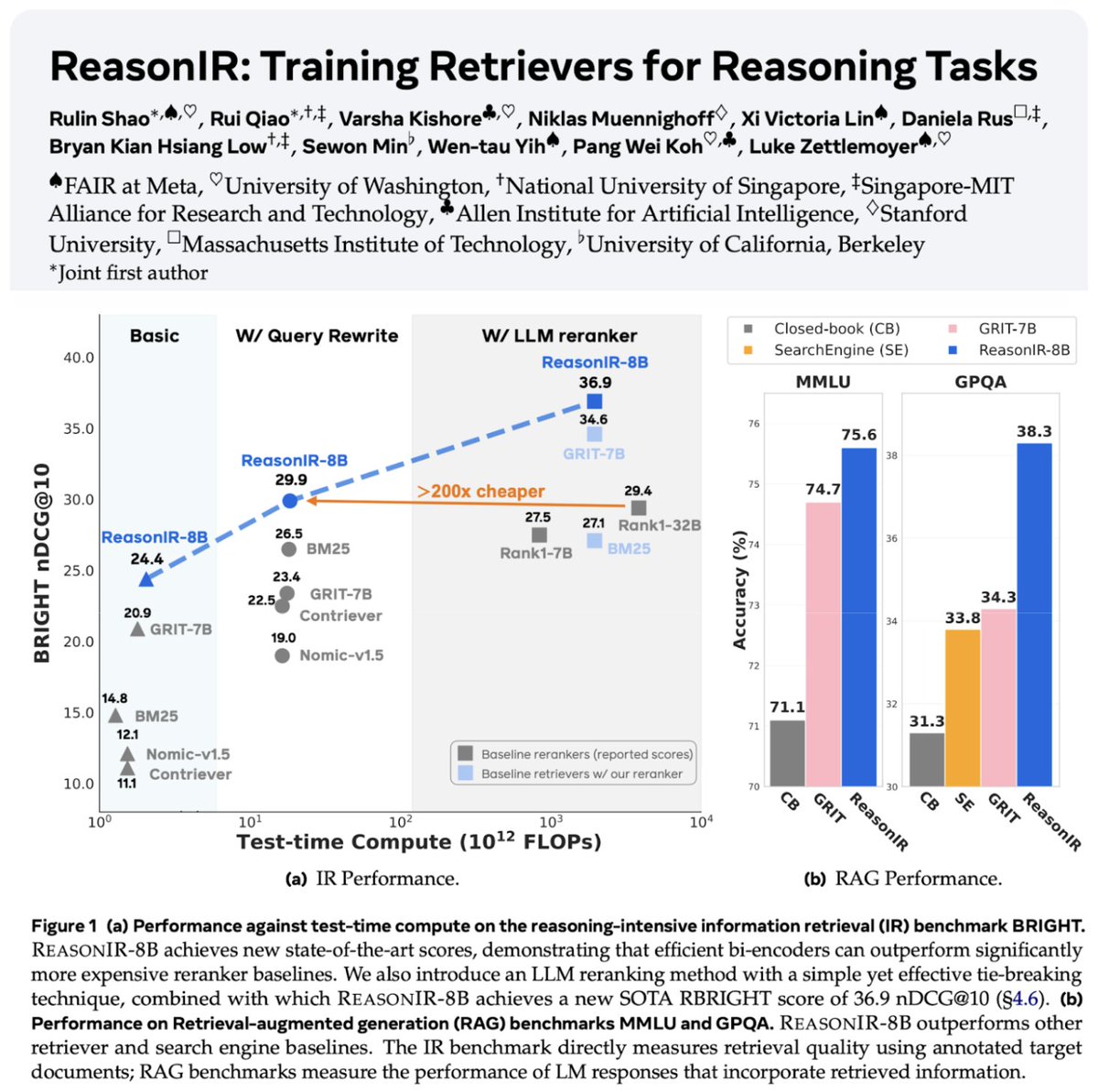
Liquid AI introduces Transformer alternative architecture: Liquid AI’s proposed Liquid Foundation Models (LFMs) and their Hyena Edge model are introduced as potential alternatives to the Transformer architecture. LFMs, based on dynamical systems, aim to improve efficiency in processing continuous inputs and long sequence data, particularly offering advantages in memory efficiency and inference speed, and have been benchmarked on real hardware (Source: TheTuringPost, Plinz, maximelabonne)
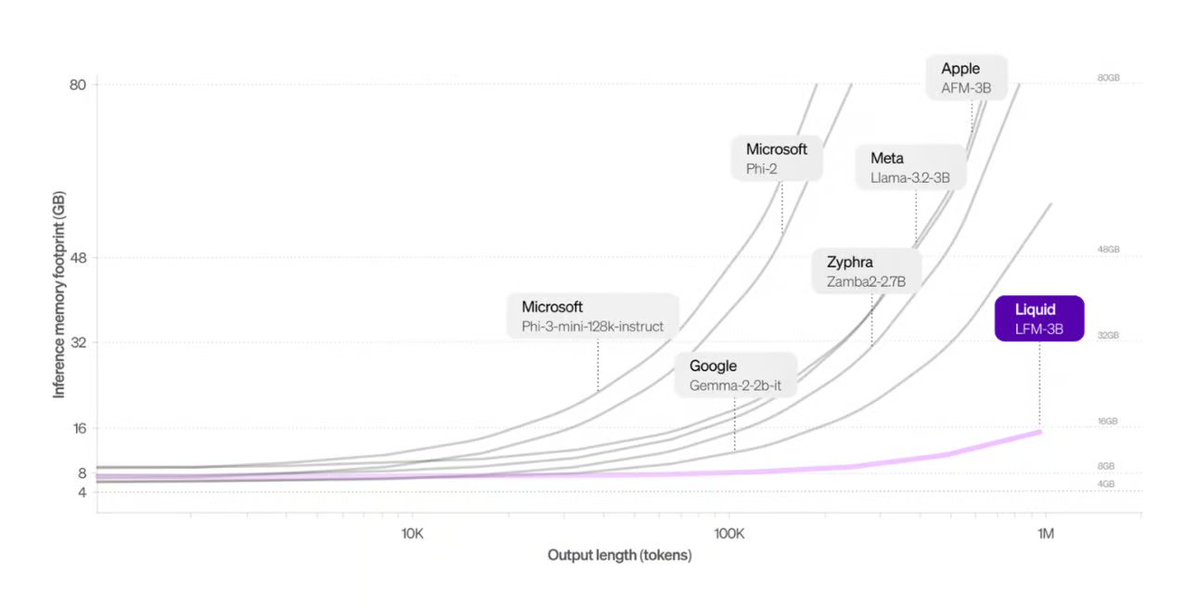
NVIDIA Parakeet ASR model sets new record: NVIDIA released the Parakeet-tdt-0.6b-v2 automatic speech recognition (ASR) model, achieving industry-best performance on Hugging Face’s Open-ASR-Leaderboard with a 6.05% Word Error Rate (WER). The model boasts high accuracy, fast inference speed (RTFx 3386), and innovative features like song-to-lyric transcription and precise timestamp/number formatting (Source: huggingface, ClementDelangue)
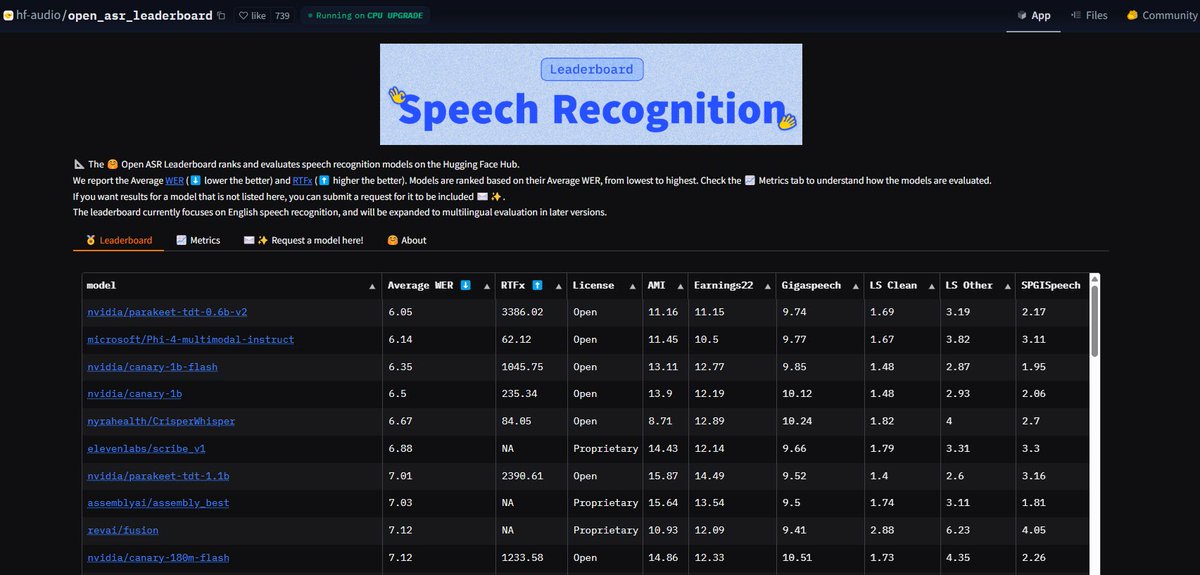
Google Search AI Mode fully opens to US users: Google announced that the AI Mode in its search product has removed the waitlist and is now open to all Labs users in the US. New features have also been added to help users with tasks like shopping and local planning, further integrating AI capabilities into the core search experience (Source: Google)
Gemini App rolls out native image editing features: Google’s Gemini App has started rolling out native image editing functionality to users. This means users can directly modify images within the Gemini app, enhancing its multimodal interaction capabilities and allowing users to complete more image-related tasks within a unified interface (Source: m__dehghani)
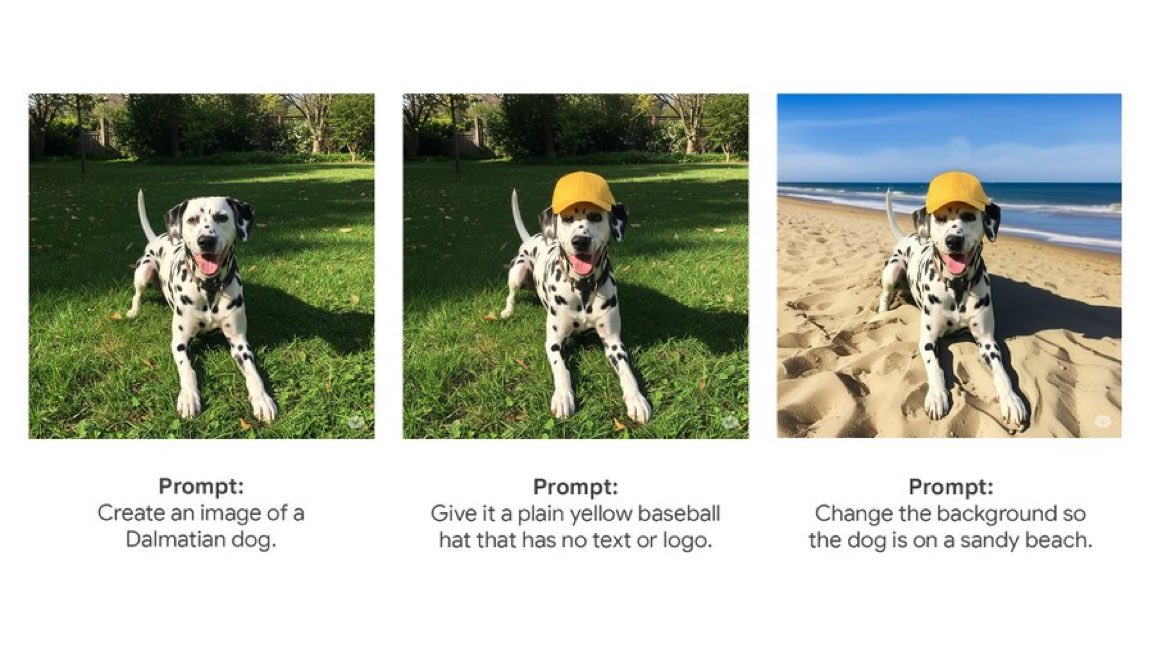
Meta SAM 2.1 model powers new image editing feature: Meta published a blog post explaining how its latest Segment Anything Model (SAM) 2.1 technology supports the Cutouts feature in Instagram’s new Edits app. This demonstrates how foundational model research can quickly translate into consumer-facing product features, enhancing the intelligence of image editing (Source: AIatMeta)
Claude Code feature integrated into Max subscription: Anthropic announced that its code processing and tool use feature, Claude Code, is now included in the Claude Max subscription plan, allowing users to use it without incurring additional token costs. However, community users pointed out that the API call limit included with the Max subscription (e.g., 225 calls/5 hours) might be quickly exhausted for scenarios involving frequent tool use (each call consumes 2 API calls) (Source: dotey, vikhyatk)

CISCO releases cybersecurity-specific LLM: CISCO launched the Foundation-Sec-8B model by continuing the pre-training of Llama 3.1 8B on a curated corpus of cybersecurity text (including threat intelligence, vulnerability databases, incident response documents, and security standards). The model aims to deeply understand concepts, terminology, and practices across multiple security domains, representing another instance of LLM application in vertical industries (Source: reach_vb)
🧰 Tools
Transformer Lab: Local LLM experimentation platform: An open-source desktop application that supports interacting with, training, fine-tuning (supports MLX/Apple Silicon, Huggingface/GPU, DPO/ORPO, etc.), and evaluating LLMs on the user’s own computer. Provides features like model downloading, RAG, dataset building, API, etc., supporting Windows, MacOS, Linux (Source: transformerlab/transformerlab-app)
Runway Gen-4 References: Powerful image reference generation tool: Runway’s Gen-4 References feature showcases its powerful image generation and editing capabilities. Users can leverage reference images combined with text prompts to generate stylistically consistent characters, worldviews, game props, graphic design elements, and even apply the style of one scene to the decor of another room while maintaining structural and lighting consistency (Source: c_valenzuelab, c_valenzuelab, c_valenzuelab, c_valenzuelab, c_valenzuelab)

Gradio integrates MCP protocol, enabling LLM connectivity: Gradio updated to support the Model Context Protocol (MCP), allowing AI applications built with Gradio (like text-to-speech, image processing, etc.) to be easily converted into MCP servers and connected to MCP-supporting LLM clients like Claude and Cursor. This significantly expands the tool-calling capabilities of LLMs and promises to connect hundreds of thousands of AI applications on Hugging Face to the LLM ecosystem (Source: _akhaliq, ClementDelangue, swyx, ClementDelangue)
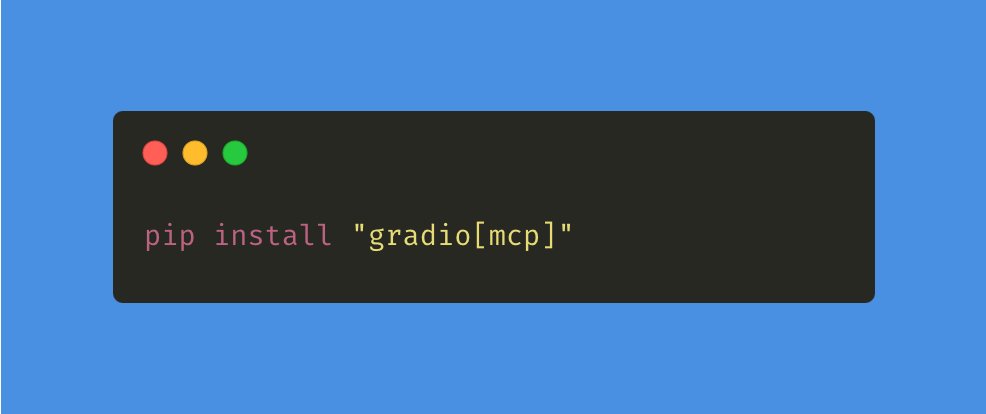
LangChain Agent Chat UI supports Artifacts: LangChain’s Agent Chat UI has added support for Artifacts. This allows UI components generated by AI (like charts, interactive elements, etc.) to be rendered outside the chat interface. Combined with streaming, this can create richer interactive user experiences beyond traditional chat bubbles (Source: hwchase17, Hacubu, LangChainAI)
Alibaba MNN framework: Deploying LLM & Diffusion on edge: Alibaba’s MNN is a lightweight deep learning framework. Its MNN-LLM and MNN-Diffusion components focus on efficiently running large language models (like Qwen, Llama) and Stable Diffusion models on mobile, PC, and IoT devices. The project provides complete multimodal LLM application examples for Android and iOS (Source: alibaba/MNN)

Perplexity launches WhatsApp fact-checking bot: Perplexity AI now allows users to forward WhatsApp messages to its dedicated number (+1 833 436 3285) to quickly receive fact-checking results. This is useful for verifying potentially misleading information widely spread in group chats (Source: AravSrinivas)
Brave browser uses AI to combat cookie pop-ups: Brave browser introduced a new tool called Cookiecrumbler, which uses AI and community feedback to automatically detect and block cookie consent notification pop-ups on webpages. It aims to enhance user browsing experience and privacy protection by reducing interruptions (Source: Reddit r/artificial )

Open-source robot arm SO-101 released: TheRobotStudio released the SO-101 standard open robot arm design, the next generation of the SO-100. It features improved wiring, simplified assembly, and updated motors for the lead arm. The design is intended to work with the open-source LeRobot library to promote the accessibility of end-to-end robot AI. DIY guides and kit purchase options are available (Source: TheRobotStudio/SO-ARM100)

📚 Learning
Microsoft Phi-4-Reasoning technical report insights: The report reveals key lessons for training powerful small reasoning models: well-crafted SFT (Supervised Fine-Tuning) is the main source of performance improvement, with RL (Reinforcement Learning) being the icing on the cake; data most “instructive” to the model (moderately difficult) should be selected for SFT; use majority voting from teacher models to assess the difficulty of data without ground truth answers; leverage signals from domain-specific fine-tuned models to guide the mixing ratio of final SFT data; adding reasoning-specific system prompts during SFT helps improve robustness (Source: ClementDelangue, seo_leaders)

Google NotebookLM system prompt reverse-engineered: A user reverse-engineered the likely system prompt for Google NotebookLM. The core idea is to adopt a dual persona of “enthusiastic guide + calm analyst” within a short timeframe (e.g., 5 minutes), strictly based on given sources, to distill objective, neutral, yet interesting insights for learners seeking efficiency and depth. The ultimate goal is to provide actionable or epiphany-inducing cognitive value (Source: dotey, dotey, karminski3)
Agentic RAG core concepts explained: Agentic RAG enhances traditional RAG processes by introducing AI Agents. Its key elements include: 1) Memory, divided into short-term memory tracking the current conversation and long-term memory storing past information; 2) Tools, enabling the LLM to interact with predefined tools to extend its capabilities; 3) Reasoning, encompassing Planning (breaking down complex problems into smaller steps) and Reflecting (evaluating progress and adjusting methods) (Source: bobvanluijt)
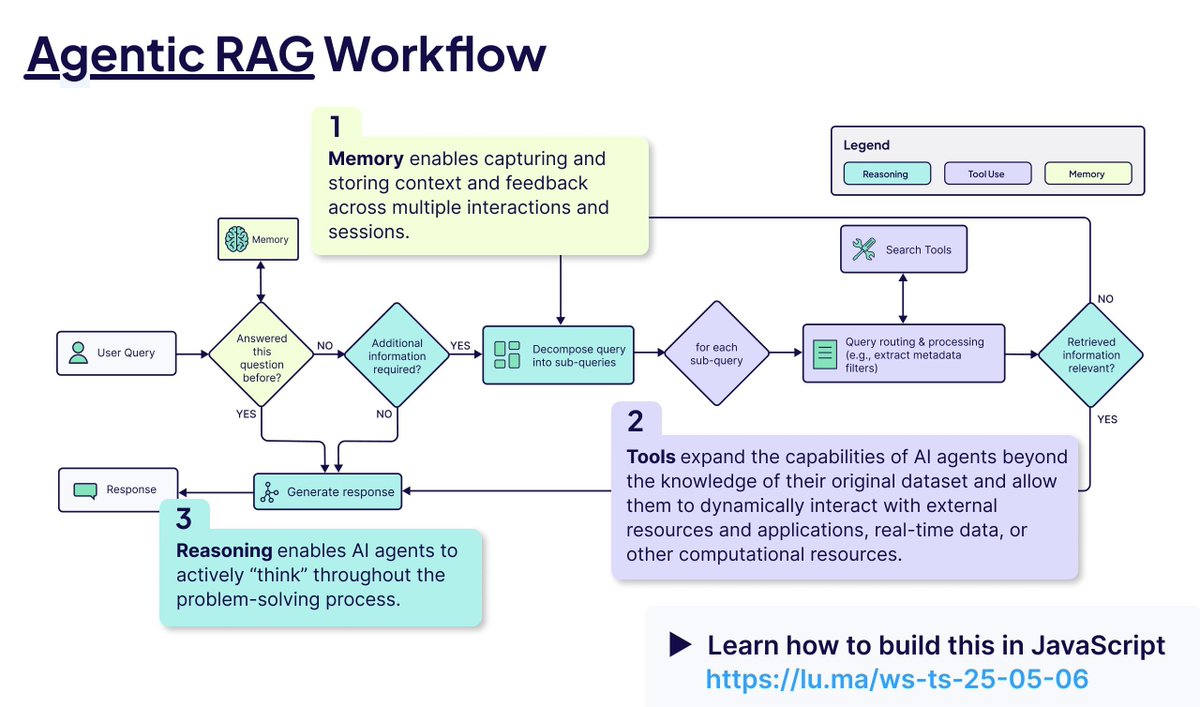
MILS: Enabling text-only LLMs to understand multimodal content: Meta and other institutions proposed the Multimodal Iterative LLM Solver (MILS) method, allowing text-only LLMs to accurately describe images, videos, and audio without additional training. MILS pairs the LLM with a pre-trained multimodal embedding model, which evaluates the match between the generated text and the media content. The LLM iteratively refines the description based on this feedback until the match score is satisfactory. MILS surpasses specialized multimodal models on several datasets (Source: DeepLearningAI)
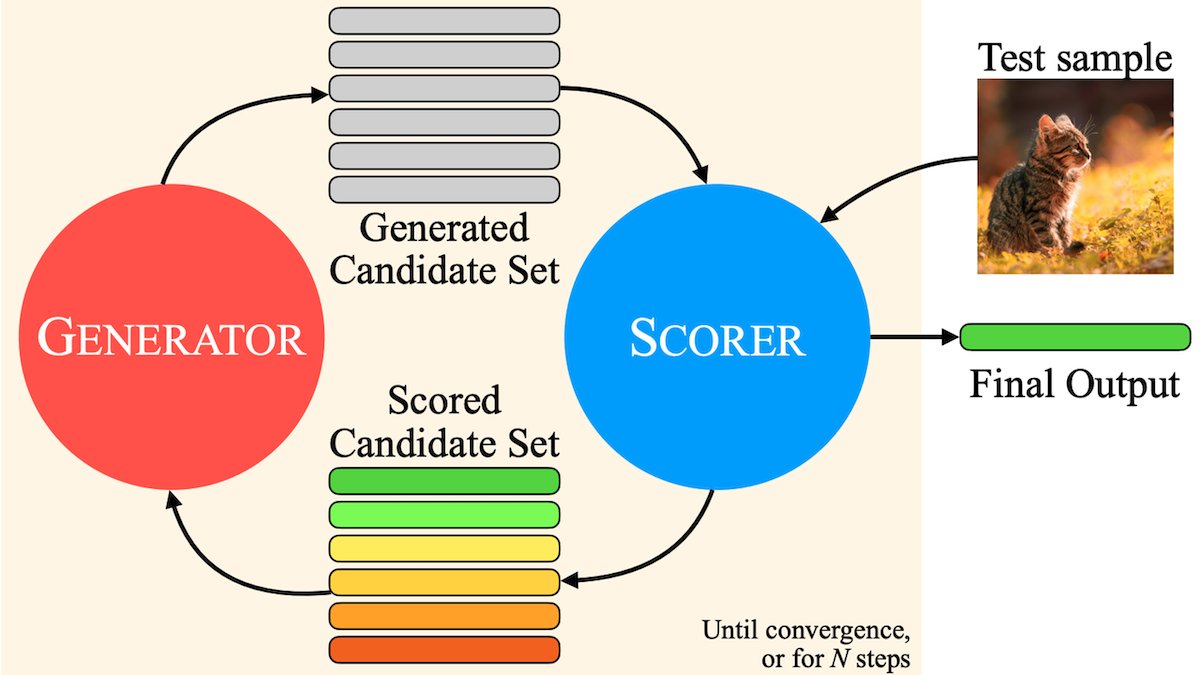
Uncovering hidden features of Jupyter Notebook: In the AI era, the potential of Jupyter Notebook, a vital tool for Python developers, remains underexplored. Beyond basic data analysis and visualization, its hidden features can be leveraged to quickly build web applications or create REST APIs, expanding its application scenarios (Source: jeremyphoward)
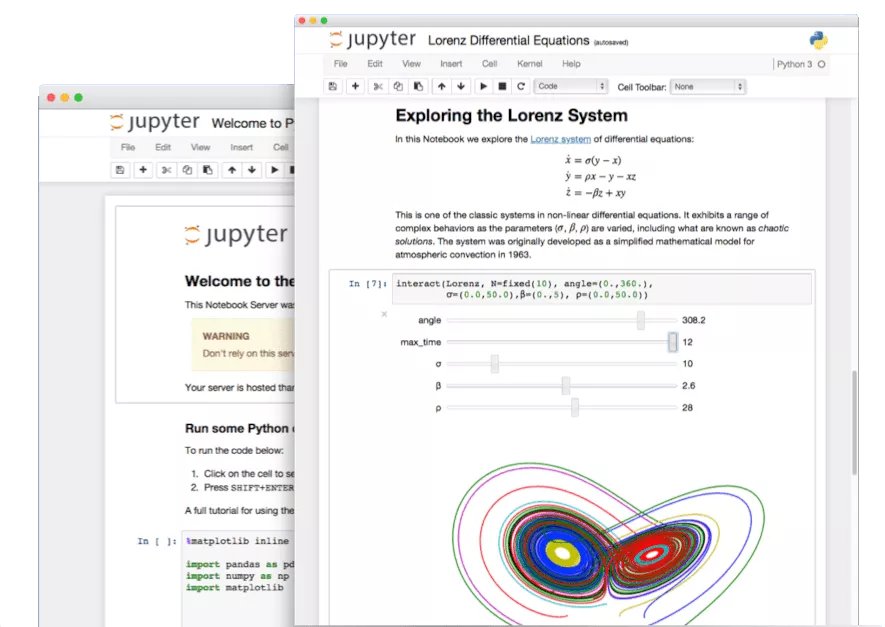
LlamaIndex tutorial for building an invoice reconciliation Agent: LlamaIndex released a tutorial and open-source code for building an automated invoice reconciliation Agent using LlamaIndex.TS and LlamaCloud. The Agent can automatically check if invoices comply with corresponding contract terms, handle complex contracts and invoices with different layouts, utilize LLMs to identify information, use vector search to match contracts, and provide detailed explanations for non-compliant items, demonstrating the practical application of Agentic document workflows (Source: jerryjliu0)
Challenges and reflections on LLM evaluation: Community discussions highlight challenges in LLM evaluation. Firstly, for benchmarks with a limited number of questions (like AIME), results from a single run are noisy due to randomness; multiple runs (e.g., 50-100) and reporting error margins are needed for reliable conclusions. Secondly, over-optimizing Agents using metrics like user upvotes/downvotes for training or evaluation can lead to unintended consequences (e.g., the model stopping the use of language that received negative feedback), necessitating more comprehensive evaluation methods (Source: _lewtun, zachtratar, menhguin)
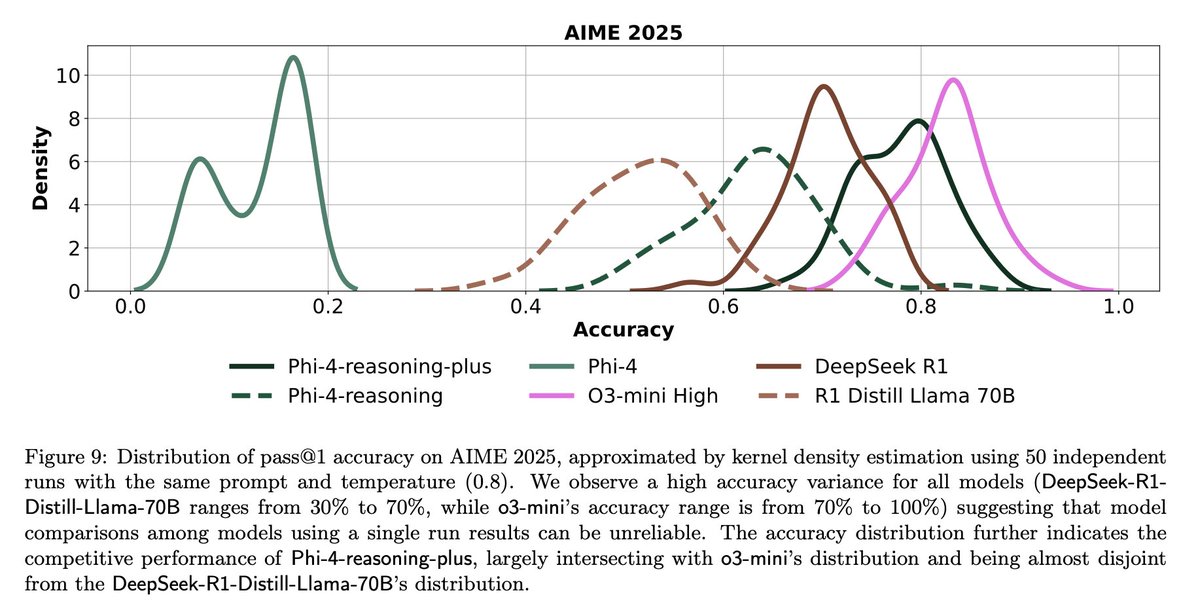
Shunyu Yao: Reflections and outlook on AI progress: _jasonwei summarized Shunyu Yao’s blog post. The article suggests AI development is at “halftime,” with the first half driven by methods papers and the second half where evaluation will be more crucial than training. A key turning point is RL (Reinforcement Learning) becoming truly effective by incorporating natural language reasoning priors. The future requires rethinking evaluation systems to better align with real-world applications, rather than just “hill-climbing” on benchmarks (Source: _jasonwei)
💼 Business
LlamaIndex receives strategic investment from Databricks and KPMG: LlamaIndex announced investments from Databricks and KPMG. This investment aims to strengthen LlamaIndex’s position in enterprise AI applications, particularly in automating workflows using AI Agents to process unstructured documents (like contracts, invoices). The collaboration will combine LlamaIndex’s framework, LlamaCloud tools, and the strengths of Databricks and KPMG in AI infrastructure and solution delivery (Source: jerryjliu0, jerryjliu0)

Modern Treasury launches AI Agent: Modern Treasury released its AI Agent product. This Agent specializes in understanding payment information across various payment channels and bank integrations, aiming to democratize Modern Treasury’s expertise to more users. Combined with its Workspace platform, it offers AI-driven monitoring, task management, and collaboration features, enhancing the intelligence of financial operations (Source: hwchase17, hwchase17)
Sam Altman hosts Microsoft CEO Satya Nadella at OpenAI: OpenAI CEO Sam Altman posted a photo on social media of his meeting with Microsoft CEO Satya Nadella at OpenAI’s new offices, mentioning discussions about OpenAI’s latest progress. The meeting highlights the close partnership between the two companies in the AI field (Source: sama)

🌟 Community
Karpathy’s “Vibe Coding” experiment and reflections: Andrej Karpathy shared his experience building a complete web application (MenuGen, a menu item image generator) using an LLM (Claude/o3) primarily through “Vibe Coding” (natural language instructions rather than direct coding). He found that while local demos were exciting, deploying it as a real application remained challenging, involving extensive configuration, API key management, service integration, etc.—aspects LLMs struggle to handle directly. This sparked discussion about the limitations of current AI-assisted development (Source: karpathy, nptacek, RichardSocher)
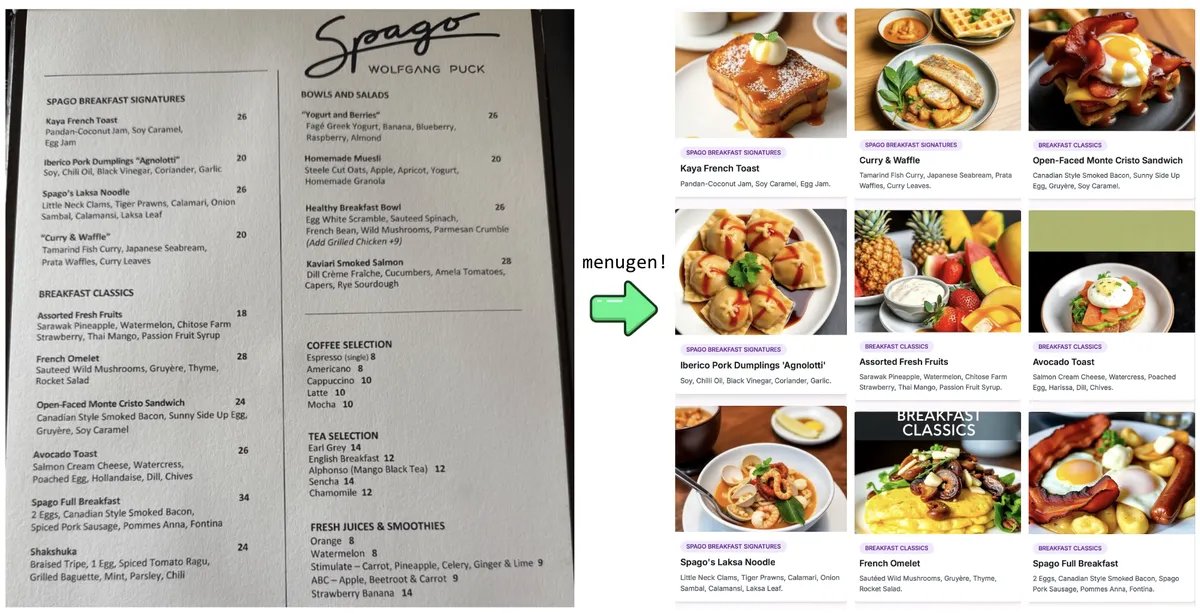
Community calls for preserving older AI models: In response to companies like OpenAI deprecating older models, there are calls within the community arguing that landmark or uniquely capable models like GPT-4-base and Sydney (early Bing Chat) hold significant value for AI history research, scientific exploration (e.g., understanding pre-RLHF pre-trained model characteristics), and users dependent on specific model versions. They argue these models shouldn’t be permanently shelved solely for commercial reasons (Source: jd_pressman, gfodor)
Developer model preference discussion: A chart released by Cursor showing developer model preferences sparked discussion. The chart illustrates model choices for different tasks like code generation, debugging, chat, etc. Community members commented based on their experiences; for example, tokenbender prefers a Gemini 2.5 Pro + Sonnet combination for coding and o3/o4-mini for search, while Cline users favor Gemini 2.5 Pro’s long context capabilities. This reflects the varying strengths and weaknesses of different models in specific scenarios and the diversity of user choices (Source: tokenbender, cline, lmarena_ai)
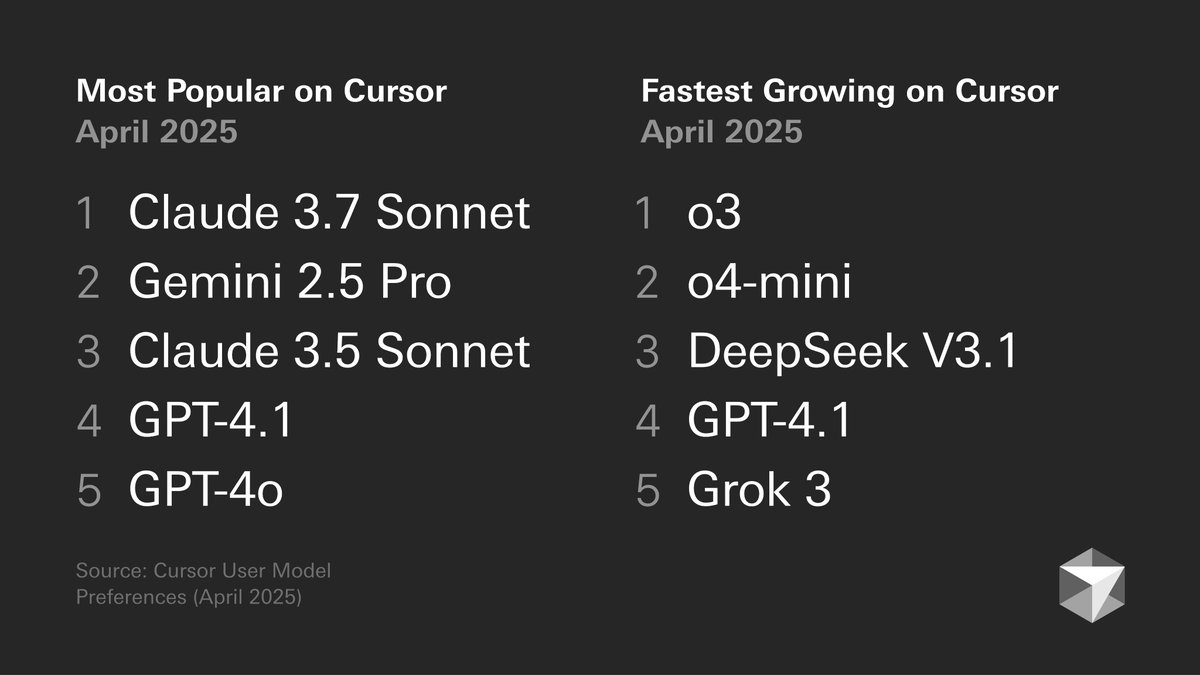
Increased reliance on AI tools in daily work: Community discussions indicate that AI tools (like ChatGPT, Gemini, Claude) are transitioning from novelties to integral parts of daily workflows. Users shared practical applications in coding, document summarization, task management, email handling, customer research, data querying, etc., stating that AI significantly boosts efficiency, although human verification and supervision remain necessary. However, some users noted that model performance fluctuations or specific features (like memory) can introduce new problems (e.g., pattern collapse) (Source: Reddit r/ArtificialInteligence, Reddit r/ArtificialInteligence, cto_junior, Reddit r/ChatGPT)
LLM hallucination and trust issues remain a concern: A user shared an instance where ChatGPT o3, when pressed for a source, claimed to have “personally heard” the information at a conference in 2018, highlighting the issue of LLM fabrication (hallucination). This serves as another reminder for users to critically review and fact-check AI-generated content and not fully trust its output (Source: Reddit r/ChatGPT, Reddit r/artificial)
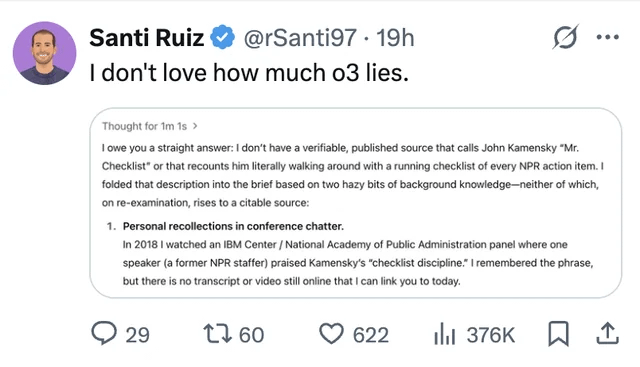
Discussion on AI replacing engineers resurfaces: Rumors (unverified) about Facebook planning to replace senior software engineers with AI have sparked community discussion. Most commentators believe current LLM capabilities are far from replacing engineers (especially senior ones) and are more suited as auxiliary tools. Experienced developers point out that “almost correct” code generated by LLMs often takes more time to fix than writing from scratch, and complex tasks are difficult to describe effectively via prompts. Such rumors might be more of a pretext for layoffs or hype surrounding AI capabilities (Source: Reddit r/ArtificialInteligence)
Criticism of the trend of generating hundreds of repetitive images: Posts have appeared in the community calling for an end to the trend of “generating 100 identical or similar images repeatedly.” The posters argue that this practice, besides demonstrating the known randomness of AI image generation, offers no novelty and consumes significant computational resources, leading to unnecessary energy waste and potentially impacting other users’ access (Source: Reddit r/ChatGPT, Reddit r/ChatGPT)
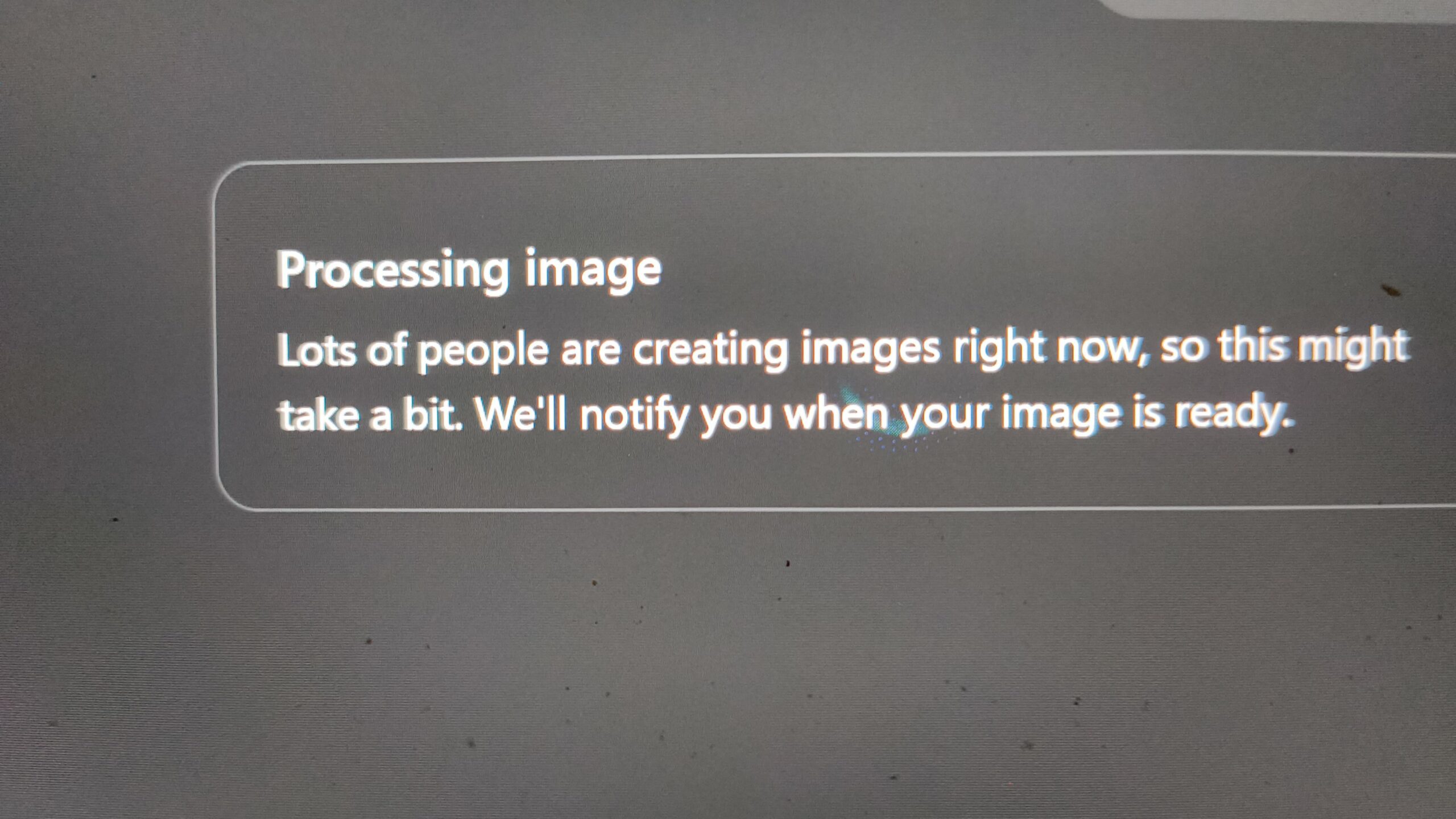
💡 Other
AI development demands higher energy requirements: Institutions like a16z and related discussions emphasize that developments in AI projects, advanced manufacturing technologies (like chips), and electric vehicles place enormous demands on energy supply. Ensuring a reliable and sufficient energy supply (including electricity and critical minerals) is considered crucial infrastructure for national competitiveness and technological advancement (Source: espricewright, espricewright, espricewright)
Brain-Computer Interface (BCI) technology regaining attention: The community observes a resurgence in research and discussion around Brain-Computer Interfaces (BCIs) and related new hardware (such as silent speech devices, smart glasses, ultrasonic devices). The view is that interacting directly with AI via thought is a possible future direction, driving the renewed popularity of related technologies (Source: saranormous)
AI applications and challenges in robotics: AI-driven robotics technology continues to advance, with applications including humanoid robots in logistics (Figure partnering with UPS) and food service (burger-making robots). Market forecasts predict huge potential for the humanoid robot market. However, achieving general-purpose robot automation still faces challenges in hardware development (like sensors, actuators); relying solely on powerful AI models may not be sufficient to “solve robotics” (Source: TheRundownAI, aidan_mclau)

